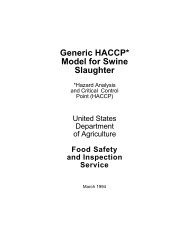Generic HACCP Model for Thermally Processed Commercial
Generic HACCP Model for Thermally Processed Commercial
Generic HACCP Model for Thermally Processed Commercial
You also want an ePaper? Increase the reach of your titles
YUMPU automatically turns print PDFs into web optimized ePapers that Google loves.
e prevented, and actions to be taken if conditions which could result in a hazard occur.<br />
In<strong>for</strong>mation on physical hazards may be more general and may consist simply of items found in<br />
foods that are injurious to human health such as glass, metal, broken needles, etc. The evaluation<br />
of physical hazards should include the suppliers utilized and their ability to provide products,<br />
ingredients, or materials that meet the food safety requirements of the plant. Past incidents of<br />
physical contamination occuring in the plant should also be a consideration when determining the<br />
significance of a hazard and the likely occurrence of a similar or related deviation. If specific<br />
chemical hazards exist that are associated with the process, these should also be considered at this<br />
point. Examples may be residues from veterinary drugs or zoonotic diseases present in animals<br />
at the time of slaughter, natural toxins, or pesticides present in non-meat ingredients.<br />
Contamination from chemicals used <strong>for</strong> cleaning, equipment maintenance or upkeep are also of<br />
concern.<br />
Creating a bibliography of the sources used will help document and provide the<br />
scientific basis <strong>for</strong> considering a hazard and determining its significance. It will also be<br />
useful when a plan is validated, reassessed, or when the hazard analysis is reassessed.<br />
Although a bibliography is a useful tool, it is not a regulatory requirement.<br />
10



